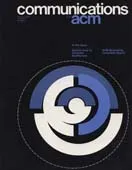January 1978 - Vol. 21 No. 1

Features
The Manchester Mark I and atlas: a historical perspective
In 30 years of computer design at Manchester University two systems stand out: the Mark I (developed over the period 1946-49) and the Atlas (1956-62). This paper places each computer in its historical context and then describes the architecture and system software in present-day terminology. Several design concepts such as address-generation and store management have evolved in the progression from Mark I to Atlas. The wider impact of Manchester innovations in these and other areas is discussed, and the contemporary performance of the Mark I and Atlas is evaluated.
The development of the MU5 computer system
Following a brief outline of the background of the MU5 project, the aims and ideas for MU5 are discussed. A description is then given of the instruction set, which includes a number of features conducive to the production of efficient compiled code from high-level language source programs. The design of the processor is then traced from the initial ideas for an associatively addressed “name store” to the final multistage pipeline structure involving a prediction mechanism for instruction prefetching and a function queue for array element accessing. An overall view of the complete MU5 complex is presented together with a brief indication of its performance.
The evolution of the Sperry Univac 1100 series: a history, analysis, and projection
The 1100 series systems are Sperry Univac's large-scale mainframe computer systems. Beginning with the 1107 in 1962, the 1100 series has progressed through a succession of eight compatible computer models to the latest system, the 1100/80, introduced in 1977. The 1100 series hardware architecture Is based on a 36-bit word, ones complement structure which obtains one operand from storage and one from a high-speed register, or two operands from high-speed registers. The 1100 Operating System is designed to support a symmetrical multiprocessor configuration simultaneously providing multiprogrammed batch, timesharing, and transaction environments.
The evolution of the DECsystem 10
The DECsystem 10, also known as the PDP-10, evolved from the PDP-6 (circa 1963) over five generations of implementations to presently include systems covering a price range of five to one. The origin and evolution of the hardware, operating system, and languages are described in terms of technological change, user requirements, and user developments. The PDP-10's contributions to computing technology include: accelerating the transition from batch oriented to time sharing computing systems; transferring hardware technology within DEC (and elsewhere) to minicomputer design and manufacturing; supporting minicomputer hardware and software development; and serving as a model for single user and timeshared interactive minicomputer/microcomputer systems.
This paper describes the CRAY-1, discusses the evolution of its architecture, and gives an account of some of the problems that were overcome during its manufacture.
The CRAY-1 is the only computer to have been built to date that satisfies ERDA's Class VI requirement (a computer capable of processing from 20 to 60 million floating point operations per second) [1].
The CRAY-1's Fortran compiler (CFT) is designed to give the scientific user immediate access to the benefits of the CRAY-1's vector processing architecture. An optimizing compiler, CFT, “vectorizes” innermost DO loops. Compatible with the ANSI 1966 Fortran Standard and with many commonly supported Fortran extensions, CFT does not require any source program modifications or the use of additional nonstandard Fortran statements to achieve vectorization. Thus the user's investment of hundreds of man months of effort to develop Fortran programs for other contemporary computers is protected.
Architecture of the IBM system/370
This paper discusses the design considerations for the architectural extensions that distinguish System/370 from System/360. It comments on some experiences with the original objectives for System/360 and on the efforts to achieve them, and it describes the reasons and objectives for extending the architecture. It covers virtual storage, program control, data-manipulation instructions, timing facilities, multiprocessing, debugging and monitoring, error handling, and input/output operations. A final section tabulates some of the important parameters of the various IBM machines which implement the architecture.



